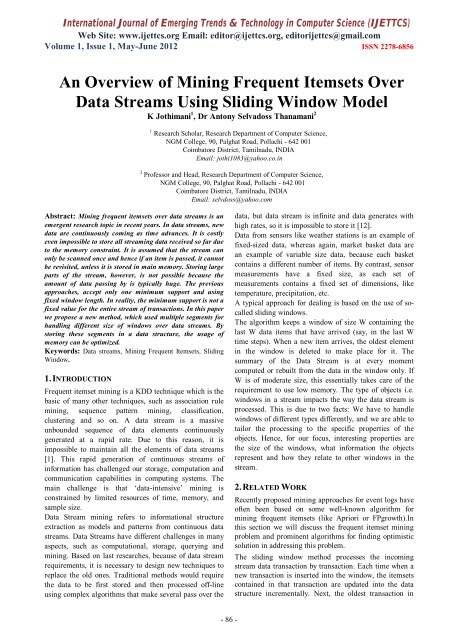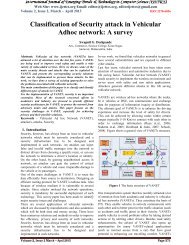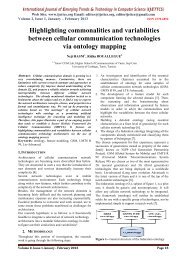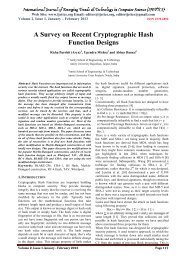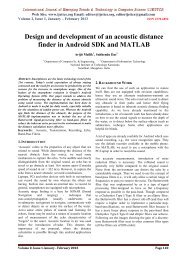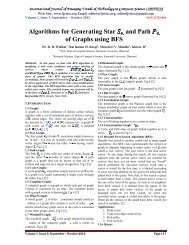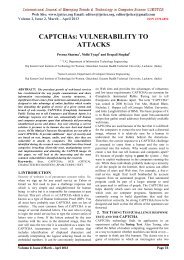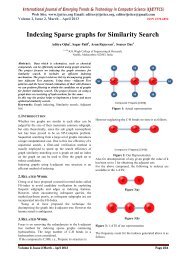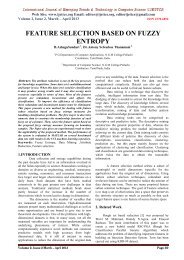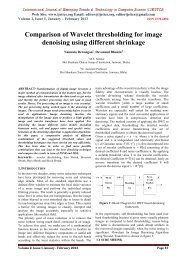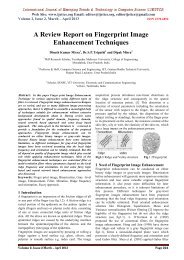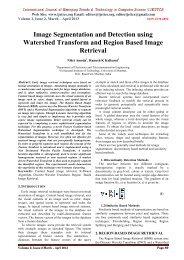An Overview of Mining Frequent Itemsets Over Data Streams Using ...
An Overview of Mining Frequent Itemsets Over Data Streams Using ...
An Overview of Mining Frequent Itemsets Over Data Streams Using ...
You also want an ePaper? Increase the reach of your titles
YUMPU automatically turns print PDFs into web optimized ePapers that Google loves.
International Journal <strong>of</strong> Emerging Trends & Technology in Computer Science (IJETTCS)Web Site: www.ijettcs.org Email: editor@ijettcs.org, editorijettcs@gmail.comVolume 1, Issue 1, May-June 2012 ISSN 2278-6856<strong>An</strong> <strong><strong>Over</strong>view</strong> <strong>of</strong> <strong>Mining</strong> <strong>Frequent</strong> <strong>Itemsets</strong> <strong>Over</strong><strong>Data</strong> <strong>Streams</strong> <strong>Using</strong> Sliding Window ModelK Jothimani 1 , Dr <strong>An</strong>tony Selvadoss Thanamani 21 Research Scholar, Research Department <strong>of</strong> Computer Science,NGM College, 90, Palghat Road, Pollachi - 642 001Coimbatore District, Tamilnadu, INDIAEmail: jothi1083@yahoo.co.in2 Pr<strong>of</strong>essor and Head, Research Department <strong>of</strong> Computer Science,NGM College, 90, Palghat Road, Pollachi - 642 001Coimbatore District, Tamilnadu, INDIAEmail: selvdoss@yahoo.comAbstract: <strong>Mining</strong> frequent itemsets over data streams is anemergent research topic in recent years. In data streams, newdata are continuously coming as time advances. It is costlyeven impossible to store all streaming data received so far dueto the memory constraint. It is assumed that the stream canonly be scanned once and hence if an item is passed, it cannotbe revisited, unless it is stored in main memory. Storing largeparts <strong>of</strong> the stream, however, is not possible because theamount <strong>of</strong> data passing by is typically huge. The previousapproaches, accept only one minimum support and usingfixed window length. In reality, the minimum support is not afixed value for the entire stream <strong>of</strong> transactions. In this paperwe propose a new method, which used multiple segments forhandling different size <strong>of</strong> windows over data streams. Bystoring these segments in a data structure, the usage <strong>of</strong>memory can be optimized.Keywords: <strong>Data</strong> streams, <strong>Mining</strong> <strong>Frequent</strong> <strong>Itemsets</strong>, SlidingWindow.1. INTRODUCTION<strong>Frequent</strong> itemset mining is a KDD technique which is thebasic <strong>of</strong> many other techniques, such as association rulemining, sequence pattern mining, classification,clustering and so on. A data stream is a massiveunbounded sequence <strong>of</strong> data elements continuouslygenerated at a rapid rate. Due to this reason, it isimpossible to maintain all the elements <strong>of</strong> data streams[1]. This rapid generation <strong>of</strong> continuous streams <strong>of</strong>information has challenged our storage, computation andcommunication capabilities in computing systems. Themain challenge is that ‘data-intensive’ mining isconstrained by limited resources <strong>of</strong> time, memory, andsample size.<strong>Data</strong> Stream mining refers to informational structureextraction as models and patterns from continuous datastreams. <strong>Data</strong> <strong>Streams</strong> have different challenges in manyaspects, such as computational, storage, querying andmining. Based on last researches, because <strong>of</strong> data streamrequirements, it is necessary to design new techniques toreplace the old ones. Traditional methods would requirethe data to be first stored and then processed <strong>of</strong>f-lineusing complex algorithms that make several pass over thedata, but data stream is infinite and data generates withhigh rates, so it is impossible to store it [12].<strong>Data</strong> from sensors like weather stations is an example <strong>of</strong>fixed-sized data, whereas again, market basket data arean example <strong>of</strong> variable size data, because each basketcontains a different number <strong>of</strong> items. By contrast, sensormeasurements have a fixed size, as each set <strong>of</strong>measurements contains a fixed set <strong>of</strong> dimensions, liketemperature, precipitation, etc.A typical approach for dealing is based on the use <strong>of</strong> socalledsliding windows.The algorithm keeps a window <strong>of</strong> size W containing thelast W data items that have arrived (say, in the last Wtime steps). When a new item arrives, the oldest elementin the window is deleted to make place for it. Thesummary <strong>of</strong> the <strong>Data</strong> Stream is at every momentcomputed or rebuilt from the data in the window only. IfW is <strong>of</strong> moderate size, this essentially takes care <strong>of</strong> therequirement to use low memory. The type <strong>of</strong> objects i.e.windows in a stream impacts the way the data stream isprocessed. This is due to two facts: We have to handlewindows <strong>of</strong> different types differently, and we are able totailor the processing to the specific properties <strong>of</strong> theobjects. Hence, for our focus, interesting properties arethe size <strong>of</strong> the windows, what information the objectsrepresent and how they relate to other windows in thestream.2. RELATED WORKRecently proposed mining approaches for event logs have<strong>of</strong>ten been based on some well-known algorithm formining frequent itemsets (like Apriori or FPgrowth).Inthis section we will discuss the frequent itemset miningproblem and prominent algorithms for finding optimisticsolution in addressing this problem.The sliding window method processes the incomingstream data transaction by transaction. Each time when anew transaction is inserted into the window, the itemsetscontained in that transaction are updated into the datastructure incrementally. Next, the oldest transaction in- 86 -
International Journal <strong>of</strong> Emerging Trends & Technology in Computer Science (IJETTCS)Web Site: www.ijettcs.org Email: editor@ijettcs.org, editorijettcs@gmail.comVolume 1, Issue 1, May-June 2012 ISSN 2278-6856the original window is dropped out, and the effect <strong>of</strong>those itemsets contained in it is also deleted. The slidingwindow method [4] also has a periodical operation toprune away unpromising itemsets from its data structure,and the frequent itemsets are output as mining resultwhenever a user requests.Two types <strong>of</strong> sliding widow, i.e., transaction- sensitivesliding window and time-sensitive sliding window, areused in mining data streams. The basic processing unit <strong>of</strong>window sliding <strong>of</strong> first type is an expired transactionwhile the basic unit <strong>of</strong> window sliding <strong>of</strong> second one is atime unit, such as a minute or an hour. In the dampedwindow model, recent sliding windows are moreimportant than previous ones.As long as the window size is reasonably large, and theconceptual drifts in the stream is not too dramatic, mostitemsets do not change their status (from frequent to nonfrequentor from non-frequent to frequent).[18] In otherwords, the effects <strong>of</strong> transactions moving in and out <strong>of</strong> awindow <strong>of</strong>fset each other and usually do not cause change<strong>of</strong> status <strong>of</strong> many involved nodes.To find frequent itemsets on a data stream, we maintain adata structure that models the current frequent itemsets.We update the data structure incrementally. Thecombinatorial explosion problem <strong>of</strong> mining frequentitemsets becomes even more serious in the streamingenvironment. As a result, on the one hand, we cannotafford keeping track <strong>of</strong> all itemsets or even frequentitemsets, because <strong>of</strong> time and space constraints. Thus, thechallenge lies in designing a compact data structurewhich does not lose information <strong>of</strong> any frequent itemsetover a sliding window.3. PROBLEM DESCRIPTIONLet I = {x1, x2, …, xz} be a set <strong>of</strong> items (or attributes).<strong>An</strong> itemset (or a pattern) X is a subset <strong>of</strong> I and written asX =xi xj…xm. The length (i.e., number <strong>of</strong> items) <strong>of</strong> anitemset X is denoted by |X|. A transaction, T, is an itemsetand T supports an itemset, X, if X⊆T. A transactionaldata stream is a sequence <strong>of</strong> continuously incomingtransactions. A segment, S, is a sequence <strong>of</strong> fixed number<strong>of</strong> transactions, and the size <strong>of</strong> S is indicated by s. Awindow, W, in the stream is a set <strong>of</strong> successive wtransactions, where w ≥ s.A sliding window in the stream is a window <strong>of</strong> n number<strong>of</strong> most recent w transactions which slides forward forevery transaction or every segment <strong>of</strong> transactions. Weadopt the notation Il to denote all the itemsets <strong>of</strong> length ltogether with their respective counts in a set <strong>of</strong>transactions (e.g., over W or S). In addition, we use Tnand Sn to denote the latest transaction and segment in thecurrent window, respectively. Thus, the current window iseither W = < Tn-w+1, …, Tn > or W = < Sn-m+1, …, Sn>, where w and m denote the size <strong>of</strong> W and the number <strong>of</strong>segments in W, respectively.A stream <strong>of</strong> itemsets F = {f i } i N is an infinite sequence <strong>of</strong>itemsets that evolves continuously. It is to be assumedthat only a small part <strong>of</strong> it can be kept in memory. Thewindow W <strong>of</strong> size w at time t is the sequence W = {f i1 , f i2,….. f in } such that f i € F \ W, i < t or i > t + w . Thecurrent window <strong>of</strong> size w <strong>of</strong> a stream F is the windowbeginning at time t - w + 1 where t is the position <strong>of</strong> thelast itemset appeared in the stream. This window includesthe most recent itemsets <strong>of</strong> the stream.4. PROBLEM DESCRIPTIONThe following definition describes the mining frequentitemsets over data streams.Definition: 1 (<strong>Mining</strong> a stream <strong>of</strong> itemsets). Given athreshold α, we say that a sequence S is frequent in awindow W <strong>of</strong> size w iff supp W (S) ≥ α. <strong>Mining</strong> a stream<strong>of</strong> itemsets consists in extracting at every time instant, allthe frequent sequences in the most recent sliding window.In approaches that considers multiple parallel streams [8,16, 18], the support <strong>of</strong> a sequence is usually defined as thenumber <strong>of</strong> streams in which this sequence appears. Herewe consider a single stream and the support <strong>of</strong> a sequenceis the number <strong>of</strong> instances <strong>of</strong> this sequence in the currentwindow corresponding to the most recent data.In this research, we employ a prefix tree which isorganized under the lexicographic order as our datastructure, and also processes the growth <strong>of</strong> itemsets in alexicographic-ordered away. A superset <strong>of</strong> an itemset X isthe one whose length is above |X| and has X as its prefix.We define Growthl(X) as the set <strong>of</strong> supersets <strong>of</strong> an itemsetX whose length are l more than that <strong>of</strong> X, where l ≥ 0.The number <strong>of</strong> itemsets in Growthl(X) is denoted by|Growthl(X)|.We adopt the symbol cnt(X) to represent the count-value(or just count) <strong>of</strong> an itemset X. The count <strong>of</strong> X over W,denoted as cntW(X), is the number <strong>of</strong> transactions in Wthat support X. So cntS(X) represents the count <strong>of</strong> X overa segment S. Given a user-specified minimum supportthreshold (ms), where 0 < ms ≤ 1, we say that X is aSegment based <strong>Frequent</strong> Itemset (FI) over W if cntW(X)ms×w, otherwise X is an infrequent itemset (IFI). TheSFI and IFI over S are defined similarly to those for W.Given a data stream in which every incoming transactionhas its items arranged in order, and a changeable value <strong>of</strong>ms specified by the user, the problem <strong>of</strong> mining SFIs overa sliding window in the stream is to find out the set <strong>of</strong>frequent itemsets over the window at different slides.SFI Algorithm:FREQUENT(k)n ‹– 0;T‹– ø;foreach i don ‹– n + 1;if i ∈T thenc i ‹– c i + 1;else if |T| < k−1 thenT‹– {i};c i ‹– 1;- 87 -
International Journal <strong>of</strong> Emerging Trends & Technology in Computer Science (IJETTCS)Web Site: www.ijettcs.org Email: editor@ijettcs.org, editorijettcs@gmail.comVolume 1, Issue 1, May-June 2012 ISSN 2278-6856else forall j ∈T doc j ‹– c j – 1;if cj = 0 then T ← T \{ j};As mentioned in Section 3, we further divide the slidingwindow into m equal-size segments <strong>of</strong> s transactions, andprocess the sliding <strong>of</strong> window incrementally in asegment-based manner. The data structure we employ tomaintain the summary information is a lexicographicorderedprefix tree modified from the one in [12]. Thistree structure mainly maintains I1, I2, and SFIs <strong>of</strong> 2-itemsets over the current window <strong>of</strong> a data stream, also ina segment-based fashion. For each itemset X belonging toI1 or I2, the corresponding node in the tree includes acircular array <strong>of</strong> size m, which corresponds to the msegments <strong>of</strong> the sliding window, and X’s count over thecurrent window is recorded respectively in these m fields.5. EXPERIMENTAL RESULTSThe goal <strong>of</strong> our experiments is to examine the time andspace behavior <strong>of</strong> our algorithm over a variety <strong>of</strong>parameter settings. More specially our goals are todetermine the following: the effective processing rate, theexistence <strong>of</strong> a time and space usage upper-bound, and thetime and space sensitivity. Since the purpose <strong>of</strong> ouralgorithm is to process an unbounded data stream.The test datasets adopted in our experiments. weredownloaded from the website <strong>of</strong> FIMI Repository [14],while others were generated using the IBM’s syntheticdata generator [15]. Every dataset has 1000 differentattributes and consists <strong>of</strong> 100 thousands <strong>of</strong> transactions.The size <strong>of</strong> sliding window in our experiments is set to50,000 transactions for both methods.The first experiment investigates the efficiency with respect tothroughput and average window-sliding time <strong>of</strong> bothmethods. Here throughput is measured as the number <strong>of</strong>transactions processed per second by the algorithms. Wereport the experimental result in the following Fig.1… (a) Throughput(b) Average window-sliding timeFigure 1 Scalability on T15.I6.D100K with varying minimumsupport threshold0The second experiment evaluates the scalability <strong>of</strong> FI and SFIwith varying the value <strong>of</strong> ms. We measure the throughput andaverage window-sliding time <strong>of</strong> both methods, which aresimilar to those in the previous experiment. The datasetadopted is T16.I8.D100K, and we vary ms from 1.5% downto 0.2%.6. CONCLUSIONIn this paper, we study the problem <strong>of</strong> mining frequentitemsets over the sliding window <strong>of</strong> a transactional datastream. Based on the improvement theory <strong>of</strong> <strong>An</strong> Efficientapproximate Inclusion–Exclusion, we devise and proposean algorithm called SFI for finding frequent itemsetsthrough an approximating approach.SFI divides the sliding window into segments and handlesthe sliding <strong>of</strong> window in a segment-based manner. Itcapable <strong>of</strong> approximating itemsets dynamically bychoosing different parameter-values for different itemsetsto be approximated. We analyze all the factors which isrelated for mining frequent itemsets over datastreams. Infuture we can improve this algorithm for large andvariable windowsReferences[1] R. Agrawal, T. Imielinski, and A. Swami.<strong>Mining</strong> Association Rules between Sets <strong>of</strong> Itemsin Large <strong>Data</strong>bases. In Proceedings <strong>of</strong> the 1993International Conference on Management <strong>of</strong><strong>Data</strong>, pp. 207-216, 1993.[2] R. Agrawal and R. Srikant. Fast Algorithms for<strong>Mining</strong> Association Rules. In Proceedings <strong>of</strong> the20th International Conference on Very Large <strong>Data</strong>Bases, pp. 487-499, 1994[3] J.H. Chang & W.S. Lee, “A sliding windowmethod for finding recently frequent itemsets overonline data streams’, Journal <strong>of</strong> InformationScience and Engineering, 20(4), 2004, pp. 753–762[4] Y. Zhu & D. Shasha, “Stat Stream: statisticalmonitoring <strong>of</strong> thousands <strong>of</strong> data streams in realtime”, Proc. 28th Conf. on Very Large <strong>Data</strong> Bases,Hong Kong, China, 2002, pp. 358–369.[5] K Jothimani, Dr <strong>An</strong>tony Selvadoss Thanmani,“MS: Multiple Segments with CombinatorialApproach for <strong>Mining</strong> <strong>Frequent</strong> <strong>Itemsets</strong> <strong>Over</strong> <strong>Data</strong><strong>Streams</strong>”, IJCES International Journal <strong>of</strong>Computer Engineering Science, Volume 2 Issue 2ISSN : 2250:3439.[6] J.H. Chang & W.S. Lee, “A sliding windowmethod for finding recently frequent itemsets overonline data streams”, Journal <strong>of</strong> Informationscience and Engineering, 20(4), 2004, pp. 753–762.[7] J. Cheng, Y. Ke, & W. Ng,” Maintaining frequentitemsets over high-speed data streams”, Proc. 10thPacific-Asia Conf. on Knowledge Discovery and<strong>Data</strong> <strong>Mining</strong>, Singapore, 2006, pp.462–467.- 88 -
International Journal <strong>of</strong> Emerging Trends & Technology in Computer Science (IJETTCS)Web Site: www.ijettcs.org Email: editor@ijettcs.org, editorijettcs@gmail.comVolume 1, Issue 1, May-June 2012 ISSN 2278-6856[8] C.K.-S. Leung & Q.I. Khan, “DSTree: a treestructure for the mining <strong>of</strong> frequent sets from datastreams,” Proc. 6th IEEE Conf. on <strong>Data</strong> <strong>Mining</strong>,Hong Kong, China, 2006, pp. 928–932.[9] Y. Chi, H. Wang, P.S. Yu, & R.R. Muntz,“Moment: maintaining closed frequent itemsetsover a stream sliding window”, Proc. 4th IEEEConf. on <strong>Data</strong> <strong>Mining</strong>, Brighton, UK, 2004, pp.59–66.[10] K.-F. Jea & C.-W. Li, “Discovering frequentitemsets over transactional data streams through anefficient and stable approximate approach, ExpertSystems with Applications”, 36(10), 2009, pp.12323–12331.[11] R. Agrawal and R. Srikant. Fast Algorithms for<strong>Mining</strong> Association Rules. In Proceedings <strong>of</strong> the20th International Conference, was supported inpart by the National Science Council in 2006.[12] F. Bodon, “A fast APRIORI implementation”,Proc. ICDM Workshop on <strong>Frequent</strong> Itemset<strong>Mining</strong> Implementations (FIMI’03), 2003.[13] <strong>Frequent</strong> Itemset <strong>Mining</strong> ImplementationsRepository (FIMI). Available:http://fimi.cs.helsinki.fi/[14] Mahnoosh Kholghi, Mohammadreza Keyvanpour,“<strong>An</strong> <strong>An</strong>alytical Framework for <strong>Data</strong> Stream<strong>Mining</strong> Techniques Based on Challenges andRequirements”, International Journal <strong>of</strong>Engineering Science and Technology (IJEST)ISSN: 0975-5462 Vol. 3 No. 3 Mar 2011.[15] N. Jiang & L. Gruenwald, “CFI-Stream: miningclosed frequent <strong>Itemsets</strong> in data streams”, Proc.12th ACM SIGKDD Conf. on KnowledgeDiscovery and <strong>Data</strong> <strong>Mining</strong>, Philadelphia,PA,USA, 2006, pp. 592–597.[16] Quest <strong>Data</strong> <strong>Mining</strong> Synthetic <strong>Data</strong> GenerationCode.[17] Available:http://www.almaden.ibm.com/cs/projects/iis/hdb/Projects/datamining/datasets/syndata.htm[18] H.F Li, S.Y. Lee, M.K. Shan, “<strong>An</strong> EfficientAlgorithm for <strong>Mining</strong> <strong>Frequent</strong> <strong>Itemsets</strong> over theEntire History <strong>of</strong> <strong>Data</strong> <strong>Streams</strong>”, In Proceedings <strong>of</strong>First International Workshop on KnowledgeDiscovery in <strong>Data</strong> <strong>Streams</strong> 9IWKDDS, 2004.[19] P. Indyk, D. Woodruff, “Optimal approximations<strong>of</strong> the frequency moments <strong>of</strong> data streams”,Proceedings <strong>of</strong> the thirty-seventh annual ACMsymposium on Theory <strong>of</strong> computing, pp.202–208,2005.Currently she is a research scholar <strong>of</strong> the Department <strong>of</strong>Computer Science, NGM College under BharathiyarUniversity, Coimbatore. She had three years <strong>of</strong> experiencein the computer field in technical as well as nontechnical. She is a life member <strong>of</strong> Indian Society forTechnical Education from the year 2009. Also she is amember <strong>of</strong> Computer Society <strong>of</strong> India(CSI). She haspublished more than ten papers in international andnational conferences including standard journals. Herarea <strong>of</strong> Interests <strong>Data</strong> mining, Knowledge Engineeringand Image Processing.Email: jothi1083@yahoo.co.inDr. <strong>An</strong>tony Selvadoss Thanamani ispresently working as Pr<strong>of</strong>essor andHead, Dept <strong>of</strong> Computer Science,NGM College, Coimbatore, India(affiliated to Bharathiar University,Coimbatore). He has published morethan 150 papers in international/national journals and conferences. He has authored manybooks on recent trends in Information Technology. Hisareas <strong>of</strong> interest include E-Learning, KnowledgeManagement, <strong>Data</strong> <strong>Mining</strong>, Networking, Parallel andDistributed Computing. He has to his credit 26 years <strong>of</strong>teaching and research experience. He is a senior member<strong>of</strong> International Association <strong>of</strong> Computer Science andInformation Technology, Singapore and Active member<strong>of</strong> Computer Science Society <strong>of</strong> India, Computer ScienceTeachers Association, New York.Email:- selvdoss@yahoo.comK Jothimani received her Bachelordegree in Computer Science fromBharathidasan University, Trichy in2003. She received her Masterdegree in Computer Applications in2008. She pursued her Master <strong>of</strong>Philosophy in Computer Science inthe year 2009 from Vinayaka Missions University, Salem.- 89 -


